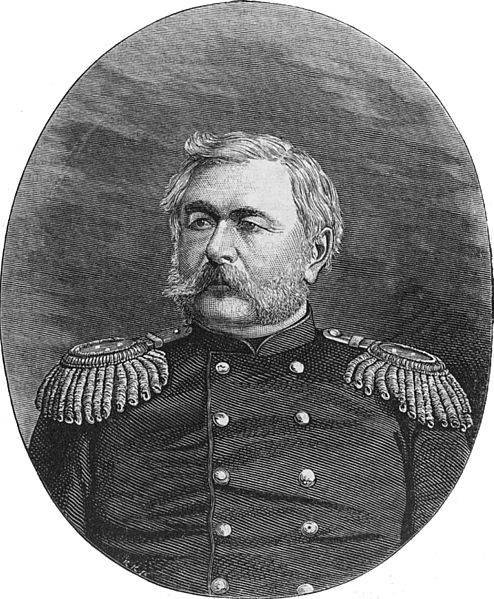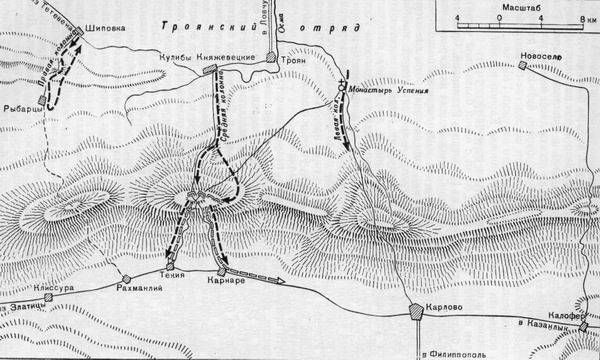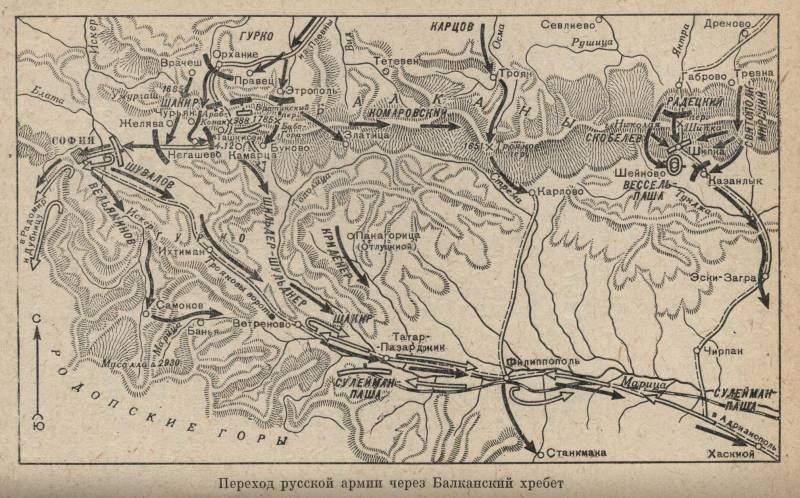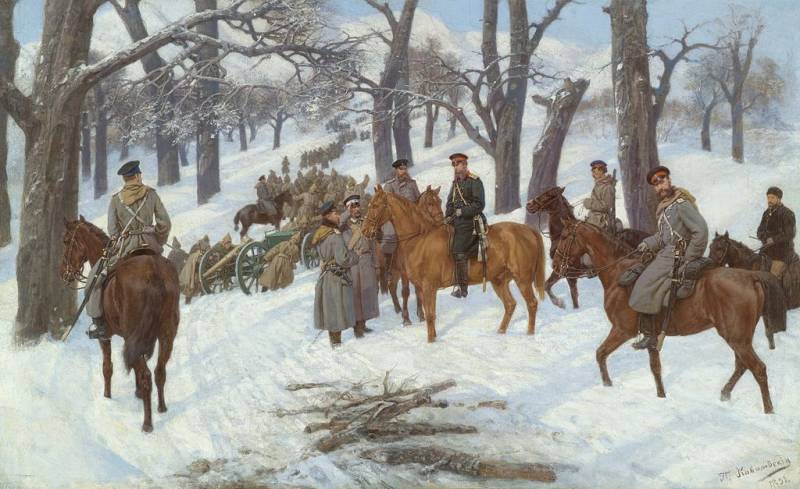"Russian troops passed here and resurrected the glory of Suvorov and Rumyantsev miraculous heroes"
Plan operation. Training
After the capture of Plevna and the entry of Serbia into the war, the Allies gained considerable superiority over the enemy. The number of Russian Danube army was 554 thousand people with 1343 guns. 48 thousand Romanian, 81,5 thousand Serbian and 14 Montenegrin troops acted against Turkey. The Turkish army could oppose Russian 183 thousand people with 441 guns. On the right flank was 100-th. Suleiman Pasha's army, in the center and on the left flank - the troops of Wessel Pasha and Shakir Pasha. Even more 60 thousand Turkish troops were diverted to Romania, Serbia and Montenegro.
After examining the situation, D. A. Milyutin suggested immediately crossing the Balkans. He believed that it was necessary to start the movement first of all with the right flank, defeat the troops of Shakir Pasha, disperse the newly formed Turkish army in the Sofia region and then force the Turks to clear the mountain passes on the southern slope of the Balkans, and in the case of their persistence to attack simultaneously them from the front and flank. 30 November (12 December) 1877 of the year at the military council, this plan was approved. The military council was attended by Tsar Alexander II, Grand Duke Nikolai Nikolayevich, Romanian Prince Karl, War Minister D. A. Milyutin, E. I. Totleben, A. A. Nepokachitsky and N. N. Obruchev.
The overall plan of the strategic operation was to keep the defense on the left wing and in the center, to overcome the Balkan mountain range, and then develop a rapid offensive on the direction of Constantinople. It was planned to cross the mountains in succession by three detachments — first by the detachment of I. V. Gurko through the Arab-Konak pass, and then by the detachment of P. P. Kartsov through the Troyanov (Trojan) pass and, finally, by the detachment of F. F. Radetsky from the Shipka Pass.
This decision was right, albeit in difficult environmental conditions - in the winter in the mountains. It was creative, it was decisive, offensive. The enemy did not expect such a quick attack. The Turkish command believed that the advance of the Russian army through the mountain range in the winter was impossible. The Turks were drawing time and hoping for help from the Western powers dissatisfied with the Russian advance in the Caucasus and the Balkans, towards the straits and Constantinople. Particularly tough was the position of England. The British actually threatened Russia with war if the Russians occupied the straits zone and Constantinople. At the same time, the Western capitals also did not expect the Russian army to break through the mountains in winter. Everyone believed that the campaign would continue in the spring of 1878.
After the decision to hike through the Balkans began, active preparation began. Attention was paid to the provision of troops with food and warm clothing. Hope for a quick delivery of all the necessary was impossible. Therefore, the squad leaders tried to ensure the maximum autonomy of the troops. Measures were taken to ensure the troops at the expense of local resources and trophies. Thus, a bakery was arranged by the forces of the Gurko detachment in Orkhaniye, where bread was baked and dried rusks were dried. At the time of the campaign, the personnel were provided with a five-day norm of crackers, tea and sugar and a three-day portion of meat. For horses, they took a three-day barley dacha. The Kartsev Trojan detachment was being prepared on its own - intendance did not help. Corn was bought, corn was ground, bread was baked and dried crackers were dried. So, dried ground for ten days was provided: four wearable and six mobile cottages. The packs, carts, fodder, buffaloes and workers from the local population were gathered through the intermediary of the former Bulgarian militia, Sergeant Major George.
Worse was the outfit. Clothing and shoes from soldiers and officers are worn out. Grand Duke Nikolai Nikolaevich 25 December 1877 of the year (6 January 1878) telegraphed Milyutin: “The Guards troops from parking and working in the high Balkans and hike through them remained at that moment - the officers and the lower ranks were equal - without boots for a long time, and now finally and without trousers. Uniforms and overcoats - some tatters and that without a pile, they have one fiber. Most of them don’t have any linen, but those who have it have left, then in pieces and decay. ” To change the situation, local people bought leather and cloth. In many parts, self-repairing boots, overcoats, uniforms and trousers.
The commanders tried to prepare the wagon train, artillery, horses and provide the troops with the entrenching tool. We tried to free the troops from everything that could hamper their movement, maneuver. They took with them only the most necessary things. The provision of ammunition troops was different. In some divisions, there was an 172 cartridge for a rifle, in the guard - by 115 ammunition, but in some cases it was only 50. For each 4-pound cannon they took an 74 projectile, for an equestrian gun - an 64 projectile. Sometimes the rate was higher. Tactical exercises were conducted. The troops were trained to conduct aimed fire, to operate in infantry chains. From the officers demanded to bring the task to each soldier.
Thus, on the eve of the campaign through the Balkan Range, the Russian command carried out a large amount of preparatory work. However, due to lack of time and material means, many measures were incomplete. Nevertheless, what has been done has played a big role in the implementation of one of the most complex operations of the Russian imperial army.
The transition of the Russian army through the Balkans
Throw Gurko squad
By mid-December 1877, the Western Gurko detachment (in fact, the whole army), which was operating in the Sofia direction, was concentrated in the area of Orhaniye and Vrachesh. He had more than 71 thousand people with 318 guns. Our troops were opposed by the troops of Shakir Pasha, who defended themselves on the Lyutakovskaya, Arab-Konakskaya and Zlatitsky positions, covering the long approaches to Sofia. Turkish troops totaled over 42 thousand people with 87 guns. As a result, Russian troops had a serious superiority - more than 1,5 times in manpower and 3,5 times in artillery.
General Gurko decided, with part of his forces, to pin down the enemy on the Lyutakovsky, Arab-Konaksky and Zlatitsky passes, and to strike the main blow between the Lyutakovsky and Arabian-Konaka positions. Then, having overcome the mountain range, develop an offensive against Sofia. According to the plan, the main forces of the detachment under the command of Lieutenant-General V.V. Kateley were to take the 13 (25) of December from Vrachev through the Churyak pass with the task to reach the Sofia highway by the end of 14 (26) of December. The actions of the main forces were provided from the right flank by the column of Lieutenant General N. N. Veliyaminov, who was supposed to go from Vrachev through the Umurgash Pass to Zhelyava. On the left flank, a column of Major-General V.D.Dandevil was advancing from Etropolis through the pass at Baba Gora to Bunovo. The remaining forces, divided into four detachments under the general command of General N. P. Kridenera, were to chain the enemy from the front. The detachments were led by generals Shuvalov, Oldenburg, Brock, and Schilder-Schuldner. They received the task in the morning of December 14 (26) to begin intensive artillery preparation, and in the event of the enemy withdrawing, to begin the pursuit immediately.
At dawn 13 (25) December 1877, the main forces of Gurko’s army began to move. The path was extremely difficult. The soldiers had to go on snow-covered paths, to overcome icy ups and downs. A snowstorm began in the mountains, there was a strong frost. At short passes, people did not have the opportunity to warm themselves. Only in the evening of 15 (27), December, the avant-garde stepped onto the Negashevo highway, throwing the enemy east to Tashkisen. The main forces, breaking the mountains, 18 (30) December concentrated near the village Churyak.
No less difficult was the march of the right-flank column of Velyaminov. At the cost of great efforts, the Russian troops reached Umurgash Pass. However, it was impossible to descend from the mountains, because the descent was very steep. By order of Gurko, the troops turned into the Churyak Pass, along which the main forces marched. Using this more convenient path, the Velyaminov detachment crossed the mountains and 17 (29) of December occupied Zhelyava.
But the path of Dandeville’s left-flanking column was especially difficult. In the evening of 14 (26) December, our troops climbed Baba Gora. In the morning they tried to move to Bunovo, but, met with strong enemy fire, were forced to retreat. 18 (28) December was fighting. The Turks counterattacked our positions on Baba Mountain, but they were rejected. In the meantime, a strong storm began. Being on the mountain has become impossible. Our troops retreated. Dandeville's column lost 813 people frostbitten and 53 people frozen. Having tidied up, in the morning of 19 (31) of December, our troops again went forward. Now they were not going through the Baba Mountain, but through the Zlatitsky Pass. 20 - 21 December 1877 (1 - 2 January 1878) The Russian squad crossed the mountains and joined the main forces of the Western squad.
Thus, the Western detachment Gurko solved the task. Although with some delay, our troops overcame the mountain range, and in the harsh winter conditions. The enemy did not expect this. Our positions bypassed Turkish positions at Lyutakov and Arab-Konak and they were under threat of a blow from the flank and rear. Turkish troops on the night of 17 (29) December left the Lyutakov district and fled to Sofia. But the Ottomans tried to hold their positions on the Arab-Konak Pass. Trying to secure this position from the strike of the enemy from the west, Shakir Pasha put forward a barrier led by Becker Pasha towards Tashkissen. In the morning of December 19 (31), Russian troops attacked the enemy. The offensive developed successfully, the Turks were knocked out of their positions. Without becoming to wait for the final outcome of the battle, Shakir Pasha left the Arab-Konak Pass. Russian pursued by Turkish troops. December 21 1877 (January 2 1878) The Turks tried to counter-strike the Velyaminov detachment from Sofia, but without success.
Western squad had the opportunity to take Sophia. For this, Gurko singled out the 15 thousand squad. However, the demoralized Turks did not defend the city and fled. On the morning of December 23 1877 (January 4 1878), the Caucasian Cossack Brigade entered Sofia. After it came the infantry. Bulgarians enthusiastically greeted their liberators. Addressing the troops, Gurko, in an order for 25's Western detachment of December 1877 (January 6, 1878), noted: “This brilliant period of this campaign, the crossing of the Balkans, in which you don’t know what to wonder about: your courage and courage in battles with the enemy or perseverance and endurance of enduring hard work in the fight against mountains, frosts and deep snow. Years will pass, and our descendants, having visited these mountains, will say with pride and triumph: "Russian troops passed here and resurrected the glory of Suvorov and Rumyantsev miracle heroes."
General Joseph Gurko in the Balkans. P. About Kovalevsky, 1891
Capture Troyanova Pass
Having received a combat mission, Kartsev ordered a final reconnaissance of the pass. Intelligence managed to find out that the highest point of the pass - Eagle's Nest - was defended by a strong Turkish detachment located in the fortifications. In going through the Balkan Mountains, Kartzov used the Chetney movement, which was widely developed in this part of the Balkan foothills. The couple arose there since the first appearance of Russian troops. So, the couple of Georgy Pulevsky protected Trojan Kolibas (hamlets) for two and a half months and sustained several fights with Turkish troops. Voevod Peto Tsetkov formed a couple in the Troyan Monastery. In addition, there were many other even numbers in 30 - 60 fighters. From the composition of these evens, Kartsov took with him the Balkans 1000 Chetniks, and they gave Russian troops serious assistance. Transport assistance from the local Bulgarian population was also very significant: the Bulgarians promised to supply 200 pack horses, the required number of buffaloes and 400 workers to clear the snow.
Thus, the detachment of General P.P. Kartsov, using the success of the troops Gurko, 23 December 1877 g. (4 January 1878 g.) Began to move through the mountains. It consisted of about 6,5 thousand people with 8 guns. But part of the troops left small garrisons on the northern side of the Balkans. Kartz decided to move in three columns. The center of gravity of all the events of crossing the mountains was concentrated in the middle column. The left column was very small, and the right did not find the way and returned back.
The middle column was moving in four echelons: the first echelon under the command of Colonel Borodin (10 th infantry battalion, one sapper company, two hundred and six guns); the second echelon under the command of the commander of the Staroingermanland regiment colonel Tatishchev (one and a half battalions and two hundred) acted on December 24 (January 5); the third echelon under the command of Major 9 of the Dukhnovsky regiment (two battalions and two hundred) began the movement of December 25 (January 6); the fourth echelon of two companies and one and a half hundred was a reserve.

General Pavel Petrovich Kartsov (1821 - 1892)
The main problem of our troops was the complexity of the route. Troyanov Pass was considered impassable. The Turks themselves preferred other ways. Here, even a small detachment could stop an entire army. Reality confirmed this opinion. According to the testimony of General Kartsov, the Russian soldiers had to move "to the waist in the snow, falling into the Yamins brought in, sliding along the bare plates." It was so hard to go that “in the 17-degree frost people poured sweat, and there was almost nothing to breathe; the air was bound with stiffness, at the height of 5000 feet was so discharged that some had bleeding from the nose, ears and throat. " Another participant of the campaign recalled: “The noise in my ears is tired, there are red circles in front of my eyes, my chest hurts and every smallest thing seems like a terrible weight ...”.
On the way I had to overcome incredible difficulties. Each front, instrument, charging box in a disassembled form was dragged along a narrow path on a specially made sled. Under the very first gun, in addition to the gunners, the 48 of the buffaloes, two companies of the 9 regiment and the 300 man of the Bulgarians had to be identified. The road to the pass was previously cleared by the Bulgarians, followed by sappers, who cut down the disturbing trees, smashed or torn stones. For 8 hours, the 9 km of ascent was covered in this way. All this time there was a thick fog, frost, chilling wind sometimes turned into short blizzards. So they dragged two guns to the pass, the rest had to be returned. As a result, the path turned out to be so difficult that in 48 hours the troops covered only 12 kilometers!
The first echelon of the Kartsov detachment reached the pass by night and attempted to suddenly seize the Turkish fortifications. Troyanov pass was defended by a Turkish detachment - a small but selective and quite combat-ready. The Turks took a strong position, almost impregnable from the front. Turkish positions consisted of a redoubt and three other fortifications, interconnected by trenches. The positions were occupied by four camps of the Nizam (regular army) and a hundred men of the Sultan Guard. Therefore, the attempt of the Russian troops a surprise attack to take the enemy fortifications was not crowned with success. The losses were small - 8 killed and 10 injured.
24 December came the second echelon, and by the morning of December 25 gathered almost the entire squad. Due to the almost inaccessibility of the Turkish positions from the front, it was decided to try to master them by circumventing their right flank. With the help of the Bulgarian Chetniks, a bypass trail was found. They decided to attack 27 in the morning on December 1877 (January 8 and 1878), launching an offensive against the Turkish forces simultaneously from the front and from their right flank. Our troops were divided into two columns and went on the attack. In 9 hours, a bypass (left) column of Colonel 30 of the Don Cossack regiment Grekov went to the enemy positions. She was met by Turkish fire, but she did not suffer any losses, as she attacked with chains and skillfully used dead spaces. Having picked up a link for a link, a detachment after a detachment almost close to the Turkish fortifications, the troops of the left column struck bayonets on the right flank of the enemy position and dislodged the enemy from there. The enemy was driven partly to the west, partly to the south along the road to Karnar, the latter was soon occupied.
With the beginning of the attack, a bypass column began the actions and troops of the right column under the command of Major Dukhnovsky. Skillfully applying the rushes, our troops approached the main Turkish redoubt with minor losses, and at that moment a battalion of a roundabout column appeared in the enemy's rear area. The Turks, seeing the enemy in their rear, trembled. The troops of the right column took advantage of this, the Russian soldiers rushed to the bayonets and partly overpowered the Turkish garrison of the redoubt, partly threw it to the south. Then the right column rushed after the retreating enemy and soon occupied Tequia. The losses of the Trojan detachment in this battle were small - only 58 people were killed and wounded, and 48 people were frostbitten.
The assault on Troyan's Pass, which are strong from the nature of positions and, moreover, defended by selected Turkish troops, almost in the absence of numerical superiority of the Russian troops, ended in victory only thanks to the skillful use of bypass traffic. Kartzov and his troops showed a brilliant example of mastering the tactics of mountain war on the Troyan Pass. Thus, the transition of the Balkan Mountains by the Trojan detachment became one of the most successfully prepared and conducted, albeit small in scale, actions of the Russian troops.
The Kartsev detachment successfully overcame the pass and went out on its southern slopes to the Karlovo area. Soon, he was joined by the 2 Brigade of the 3 Infantry Division, which arrived from the Gurko squadron. The number of the detachment increased to 6,5 thousand people.

Transition Balkan Trojan squad
To be continued ...


Information